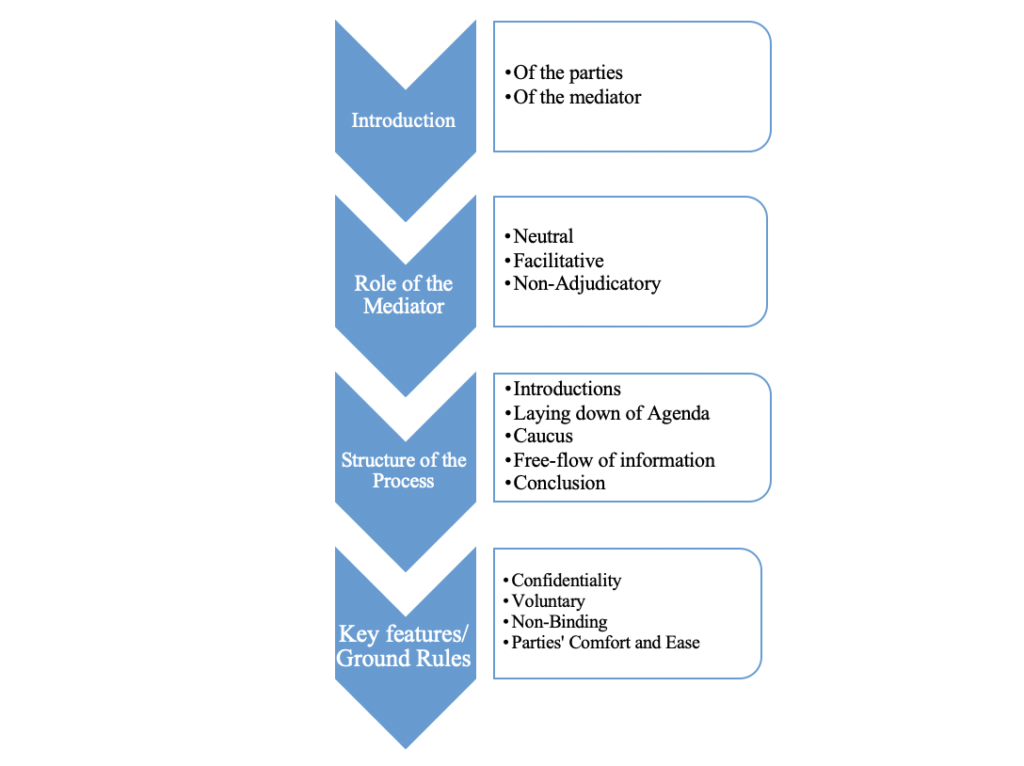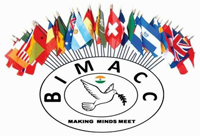
A-Z of ADR: Opening Statement – Breaking the Ice – A Mediator’s Opening Statement
-Shreya Gajbhiye (IV Year, NLSIU Bangalore)
Mediation is the process where two disputing parties approach a neutral third party to facilitate their discussion and in doing so, resolve the conflict. This nuanced process aims to resolve the conflict efficiently and without having to resort to litigation. Therefore the modalities and the conduct of the process significantly differ from the usual courtroom setting that the parties might be used to.[1] In very simplified terms, the purpose of an opening statement is to hence break the ice between the parties and the mediator. It is a monologue that formally commences the process.
Introduction
The process begins with an introduction stage. This is a definitive characteristic of the opening statement.[2] The mediator will introduce themselves and welcome both the parties to the table. This is important to establish the legitimacy of the process and convey the competence and skill of the mediator in order to gain their trust. In case the parties are not familiar with each other, they are introduced as well. It is helpful in determining how each party is to be addressed and gauge what their general attitude is towards and expectations from the process. Here mediator explains their own role as being neutral, unbiased and purely facilitative. This is to clarify to the parties that the reins of the process are with them and the mediator will only interject to moderate the discussion in order to not let it stray away from the agenda.[3] The mediator highlights that there is no element of judgement involved anywhere since they are a non-adjudicative entity, neutral at their very core.
Structure of the Process
Once this is out of the way, the mediator moves on to explain the structure of the process. After the opening statement of the mediator is concluded, the parties are invited to give their introductions. It generally begins with the party that initiated the process and entails both the parties laying down their positions and interests. Free flow of information is particularly encouraged by the mediator in order to facilitate the discussion in the most productive manner.[4] The mediator explains how this is crucial to arrive at creative solutions. The parties are also informed that after their introductions, an agenda will be laid down by the mediator, which will dictate the course of the process. The concept of a caucus – which is a brief private session with the mediator[5] – is explained, letting the parties know that it is an optional tool they can avail.
Features
After the structure is explained, the mediator elucidates on the key features of the process which serve as general principles for the parties to keep in mind throughout the process. Throughout the process, the utmost confidentiality is to be maintained and an opening statement generally contains a few sentences reminding the parties that whatever they disclose during the process will stay within the four walls of the room. The mediator as well and the opposite party is bound in good faith to maintain this confidentiality.[6]
It is a party-driven and voluntary process, which the mediator elucidates on in the opening statement by reminding the parties that they are in complete control of what issues to be discussed and what arrangement is reached. This ties in with the non-binding nature of the process, where the parties are informed that they can choose to refuse or negotiate the proposals of the other party. They will not be bound by anything put forth on the table unless both the parties intend it so.[7]
Ultimately, the objective of the opening statement is to leave no doubt in the parties’ mind with respect to the process that they are about to engage in. Equally important is that both the parties are made to feel totally comfortable, at ease and in control of the process so that the discussion can be carried out in good faith, creatively and without hesitation.
Hence, to sum up, the Opening Statement needs to cover the following:

[1] James J. Alfini, Mediation Theory and Practice, (first published 2001, LexisNexis 2006) 391.
[2] id.
[3] Richard Byrne, ‘Opening Statements in Mediation – Don’t Pass up the Opportunity’ (JDSupra, 12 June, 2018) <https://www.jdsupra.com/legalnews/opening-statements-in-mediation-don-t-91288/> accessed on 03 August 2020.
[4] Allan Stitt, ‘In defence of Opening Statements at Mediation’ (ADR Chambers, 28 October 2009) <https://adrchambers.com/news-articles/commentary/defence-opening-statements-mediation> accessed on 03 August 2020.
[5] supra note 1.
[6] supra note 4.
[7] Robert A. Berlin, ‘Sample Mediator’s Opening Statement’ (Mediate.com, 1 May 2017) <https://www.mediate.com/articles/berlinB1.cfm> accessed on 03 August 2020.
-Shreya Gajbhiye (IV Year, NLSIU Bangalore)
Shreya Gajbhiye is a fourth-year student from the National Law School of India University (NLSIU), Bangalore.
BIMACC expresses its gratitude towards the author and to the members of the Legal Services Clinic, National Law School of India University (NLSIU) for their support in our collaborative efforts to promote ADR with this series titled “A-Z of ADR”. The purpose of this series is to increase the understanding of certain fundamental concepts of Alternative Dispute Resolution.
The Legal Services Clinic is a student-run committee that provides free legal services to the socially and the economically backward sections of the society who have difficulty accessing the judicial system. It also has a mandate of spreading legal awareness and providing free legal assistance to those who cannot afford it.
Website: www.legalservicesclinic.org/
Facebook: @legalservicesclinic
Email: lsc.nlsiu@gmail.com
Phone Number: 073586 73214
Disclaimer: The views and opinions expressed in this blog are those of the author and do not necessarily reflect the official policy or position of BIMACC, any of the members of the Board, or the empanelled neutrals. This blog is for informative purpose only and does not constitute legal advice in any manner whatsoever.
